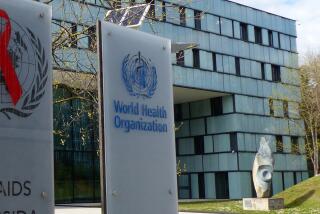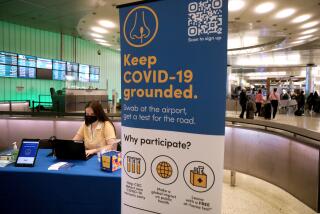Some Ebola experts worry virus may spread more easily than assumed

Some Ebola experts worry that the virus may spread more easily than thought -- through the air in small spaces, for example.
- Share via
Reporting from BETHESDA, Md. — U.S. officials leading the fight against history’s worst outbreak of Ebola have said they know the ways the virus is spread and how to stop it. They say that unless an air traveler from disease-ravaged West Africa has a fever of at least 101.5 degrees or other symptoms, co-passengers are not at risk.
“At this point there is zero risk of transmission on the flight,” Dr. Thomas Frieden, director of the federal Centers for Disease Control and Prevention, said after a Liberian man who flew through airports in Brussels and Washington was diagnosed with the disease last week in Dallas.
Other public health officials have voiced similar assurances, saying Ebola is spread only through physical contact with a symptomatic individual or their bodily fluids. “Ebola is not transmitted by the air. It is not an airborne infection,” said Dr. Edward Goodman of Texas Health Presbyterian Hospital in Dallas, where the Liberian patient remains in critical condition.
Yet some scientists who have long studied Ebola say such assurances are premature — and they are concerned about what is not known about the strain now on the loose. It is an Ebola outbreak like none seen before, jumping from the bush to urban areas, giving the virus more opportunities to evolve as it passes through multiple human hosts.
Dr. C.J. Peters, who battled a 1989 outbreak of the virus among research monkeys housed in Virginia and who later led the CDC’s most far-reaching study of Ebola’s transmissibility in humans, said he would not rule out the possibility that it spreads through the air in tight quarters.
“We just don’t have the data to exclude it,” said Peters, who continues to research viral diseases at the University of Texas in Galveston.
Dr. Philip K. Russell, a virologist who oversaw Ebola research while heading the U.S. Army’s Medical Research and Development Command, and who later led the government’s massive stockpiling of smallpox vaccine after the Sept. 11 terrorist attacks, also said much was still to be learned. “Being dogmatic is, I think, ill-advised, because there are too many unknowns here.”
If Ebola were to mutate on its path from human to human, said Russell and other scientists, its virulence might wane — or it might spread in ways not observed during past outbreaks, which were stopped after transmission among just two to three people, before the virus had a greater chance to evolve. The present outbreak in West Africa has killed approximately 3,400 people, and there is no medical cure for Ebola.
“I see the reasons to dampen down public fears,” Russell said. “But scientifically, we’re in the middle of the first experiment of multiple, serial passages of Ebola virus in man.... God knows what this virus is going to look like. I don’t.”
Tom Skinner, a spokesman for the CDC in Atlanta, said health officials were basing their response to Ebola on what has been learned from battling the virus since its discovery in central Africa in 1976. The CDC remains confident, he said, that Ebola is transmitted principally by direct physical contact with an ill person or their bodily fluids.
Skinner also said the CDC is conducting ongoing lab analyses to assess whether the present strain of Ebola is mutating in ways that would require the government to change its policies on responding to it. The results so far have not provided cause for concern, he said.
The researchers reached in recent days for this article cited grounds to question U.S. officials’ assumptions in three categories.
One issue is whether airport screenings of prospective travelers to the U.S. from West Africa can reliably detect those who might have Ebola. Frieden has said the CDC protocols used at West African airports can be relied on to prevent more infected passengers from coming to the U.S.
“One hundred percent of the individuals getting on planes are screened for fever before they get on the plane,” Frieden said Sept. 30. “And if they have a fever, they are pulled out of the line, assessed for Ebola, and don’t fly unless Ebola is ruled out.”
Individuals who have flown recently from one or more of the affected countries suggested that travelers could easily subvert the screening procedures — and might have incentive to do so: Compared with the depleted medical resources in the West African countries of Liberia, Sierra Leone and Guinea, the prospect of hospital care in the U.S. may offer an Ebola-exposed person the only chance to survive.
A person could pass body temperature checks performed at the airports by taking ibuprofen or any common analgesic. And prospective passengers have much to fear from identifying themselves as sick, said Kim Beer, a resident of Freetown, the capital of Sierra Leone, who is working to get medical supplies into the country to cope with Ebola.
“It is highly unlikely that someone would acknowledge having a fever, or simply feeling unwell,” Beer said via email. “Not only will they probably not get on the flight — they may even be taken to/required to go to a ‘holding facility’ where they would have to stay for days until it is confirmed that it is not caused by Ebola. That is just about the last place one would want to go.”
Liberian officials said last week that the patient hospitalized in Dallas, Thomas Eric Duncan, did not report to airport screeners that he had had previous contact with an Ebola-stricken woman. It is not known whether Duncan knew she suffered from Ebola; her family told neighbors it was malaria.
The potential disincentive for passengers to reveal their own symptoms was echoed by Sheka Forna, a dual citizen of Sierra Leone and Britain who manages a communications firm in Freetown. Forna said he considered it “very possible” that people with fever would medicate themselves to appear asymptomatic.
It would be perilous to admit even nonspecific symptoms at the airport, Forna said in a telephone interview. “You’d be confined to wards with people with full-blown disease.”
On Monday, the White House announced that a review was underway of existing airport procedures. Frieden and President Obama’s assistant for homeland security and counter-terrorism, Lisa Monaco, said Friday that closing the U.S. to passengers from the Ebola-affected countries would risk obstructing relief efforts.
CDC officials also say that asymptomatic patients cannot spread Ebola. This assumption is crucial for assessing how many people are at risk of getting the disease. Yet diagnosing a symptom can depend on subjective understandings of what constitutes a symptom, and some may not be easily recognizable. Is a person mildly fatigued because of short sleep the night before a flight — or because of the early onset of disease?
Moreover, said some public health specialists, there is no proof that a person infected — but who lacks symptoms — could not spread the virus to others.
“It’s really unclear,” said Michael Osterholm, a public health scientist at the University of Minnesota who recently served on the U.S. government’s National Science Advisory Board for Biosecurity. “None of us know.”
Russell, who oversaw the Army’s research on Ebola, said he found the epidemiological data unconvincing.
“The definition of ‘symptomatic’ is a little difficult to deal with,” he said. “It may be generally true that patients aren’t excreting very much virus until they become ill, but to say that we know the course of [the virus’ entry into the bloodstream] and the course of when a virus appears in the various secretions, I think, is premature.”
The CDC’s Skinner said that while officials remained confident that Ebola can be spread only by the overtly sick, the ongoing studies would assess whether mutations that might occur could increase the potential for asymptomatic patients to spread it.
Finally, some also question the official assertion that Ebola cannot be transmitted through the air. In late 1989, virus researcher Charles L. Bailey supervised the government’s response to an outbreak of Ebola among several dozen rhesus monkeys housed for research in Reston, Va., a suburb of Washington.
What Bailey learned from the episode informs his suspicion that the current strain of Ebola afflicting humans might be spread through tiny liquid droplets propelled into the air by coughing or sneezing.
“We know for a fact that the virus occurs in sputum and no one has ever done a study [disproving that] coughing or sneezing is a viable means of transmitting,” he said. Unqualified assurances that Ebola is not spread through the air, Bailey said, are “misleading.”
Peters, whose CDC team studied cases from 27 households that emerged during a 1995 Ebola outbreak in Democratic Republic of Congo, said that while most could be attributed to contact with infected late-stage patients or their bodily fluids, “some” infections may have occurred via “aerosol transmission.”
Skinner of the CDC, who cited the Peters-led study as the most extensive of Ebola’s transmissibility, said that while the evidence “is really overwhelming” that people are most at risk when they touch either those who are sick or such a person’s vomit, blood or diarrhea, “we can never say never” about spread through close-range coughing or sneezing.
“I’m not going to sit here and say that if a person who is highly viremic … were to sneeze or cough right in the face of somebody who wasn’t protected, that we wouldn’t have a transmission,” Skinner said.
Peters, Russell and Bailey, who in 1989 was deputy commander for research of the Army’s Medical Research Institute of Infectious Diseases, in Frederick, Md., said the primates in Reston had appeared to spread Ebola to other monkeys through their breath.
The Ebola strain found in the monkeys did not infect their human handlers. Bailey, who now directs a biocontainment lab at George Mason University in Virginia, said he was seeking to research the genetic differences between the Ebola found in the Reston monkeys and the strain currently circulating in West Africa.
Though he acknowledged that the means of disease transmission among the animals would not guarantee the same result among humans, Bailey said the outcome may hold lessons for the present Ebola epidemic.
“Those monkeys were dying in a pattern that was certainly suggestive of coughing and sneezing — some sort of aerosol movement,” Bailey said. “They were dying and spreading it so quickly from cage to cage. We finally came to the conclusion that the best action was to euthanize them all.”
More to Read
Sign up for Essential California
The most important California stories and recommendations in your inbox every morning.
You may occasionally receive promotional content from the Los Angeles Times.











